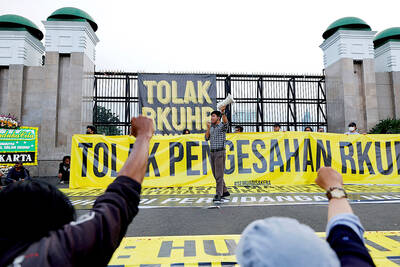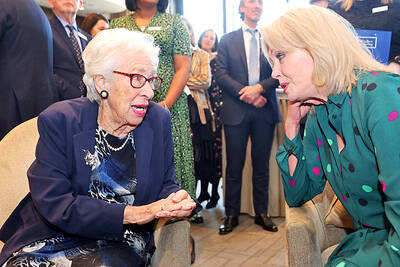Two US adventurers began their attempt to re-enact the first nonstop flight across the Atlantic, flying from Newfoundland, Canada to Ireland.
After three weeks of weather delays and technical glitches, millionaire adventurer Steve Fossett and co-pilot Mark Rebholz left St. John's for Clifden, Ireland, on Saturday under cloudy skies and in high wind at 7:20pm Newfoundland time Saturday, said Dean Williams, a spokesman for the pilots.
Eighty-six years ago, British pilot John Alcock and US pilot Arthur Whitten-Brown took off from a makeshift runway in Newfoundland in a bid to make the first nonstop flight across the Atlantic. They ended up nose-down in an Irish bog, but nonetheless made history in 1919. The journey took 16 hours and 22 minutes.
delayed take-off
Fossett and Rebholz are trying to re-enact the 3,040km flight in a replica of the Vickers Vimy biplane. They hoped to take off June 14 -- the anniversary of the original flight -- but were grounded in St. John's for more than a week waiting for good flying weather. A planned departure for June 25 was also canceled because of equipment malfunction.
Although the predicted showers held off Saturday evening, the strong winds made for a rough launch.
"You could see that the wings were moving in the wind from takeoff," Williams said.
Since much of the up to 22-hour flight will be at night, they needed good weather over the Atlantic Ocean and in Ireland. Such ideal conditions along the entire route only occur about once a week.
Fossett, 60, and Rebholz, 52, spent the hours before the launch looking over the plane and testing its engine, Williams said.
After a farewell news conference just before takeoff, the pilots donned survival suits designed to keep them warm and settled in the plane.
"They were very concentrated, very excited obviously and quite happy to finally be taking off," Williams said.
record-holder
In March, Fossett became the first person to fly around the world solo without stopping or refueling. He also holds the record for the first solo balloon flight around the world.
The aircraft they will pilot is as close a replica as possible to the Vickers Vimy flown by Alcock and Whitten-Brown, but it has a taller wheel, modern engines and brakes and radios. But Rebholz is relying on the same, now-archaic, equipment that Brown used for navigation -- a sextant and magnetic compass.
With its 21m double wing span, insect-like body and the loud buzz of its engines that propel the plane at about 120km per hour, the biplane looks more like a giant dragonfly than an aircraft. The pilots' heads stick out of the open cockpit.
1913 challenge
The flight they will try to re-create was born out of a challenge issued in 1913 by the owner of the London Daily Mail. The offer was ?10,000 to the first pilots who fly from North America to the UK in under 72 hours.
For six years the challenge went unanswered.
Then in 1919 four teams, including Alcock and Brown, attempted to make their way to Newfoundland, the closest point in North America to the United Kingdom.
In the weeks before Alcock and Brown took to the air from Lester's Field, just outside St. John's, two of the teams crashed while the other didn't make it off the ground.
Fossett and Rebholz hope to land on the eighth hole on Clifden's Connemara Golf Links.

Indonesia yesterday began enforcing its newly ratified penal code, replacing a Dutch-era criminal law that had governed the country for more than 80 years and marking a major shift in its legal landscape. Since proclaiming independence in 1945, the Southeast Asian country had continued to operate under a colonial framework widely criticized as outdated and misaligned with Indonesia’s social values. Efforts to revise the code stalled for decades as lawmakers debated how to balance human rights, religious norms and local traditions in the world’s most populous Muslim-majority nation. The 345-page Indonesian Penal Code, known as the KUHP, was passed in 2022. It

US President Donald Trump on Friday said Washington was “locked and loaded” to respond if Iran killed protesters, prompting Tehran to warn that intervention would destabilize the region. Protesters and security forces on Thursday clashed in several Iranian cities, with six people reported killed, the first deaths since the unrest escalated. Shopkeepers in Tehran on Sunday last week went on strike over high prices and economic stagnation, actions that have since spread into a protest movement that has swept into other parts of the country. If Iran “violently kills peaceful protesters, which is their custom, the United States of America will come to

Auschwitz survivor Eva Schloss, the stepsister of teenage diarist Anne Frank and a tireless educator about the horrors of the Holocaust, has died. She was 96. The Anne Frank Trust UK, of which Schloss was honorary president, said she died on Saturday in London, where she lived. Britain’s King Charles III said he was “privileged and proud” to have known Schloss, who cofounded the charitable trust to help young people challenge prejudice. “The horrors that she endured as a young woman are impossible to comprehend and yet she devoted the rest of her life to overcoming hatred and prejudice, promoting kindness, courage, understanding

‘DISRESPECTFUL’: Katie Miller, the wife of Trump’s most influential adviser, drew ire by posting an image of Greenland in the colors of the US flag, captioning it ‘SOON’ US President Donald Trump on Sunday doubled down on his claim that Greenland should become part of the US, despite calls by the Danish prime minister to stop “threatening” the territory. Washington’s military intervention in Venezuela has reignited fears for Greenland, which Trump has repeatedly said he wants to annex, given its strategic location in the arctic. While aboard Air Force One en route to Washington, Trump reiterated the goal. “We need Greenland from the standpoint of national security, and Denmark is not going to be able to do it,” he said in response to a reporter’s question. “We’ll worry about Greenland in